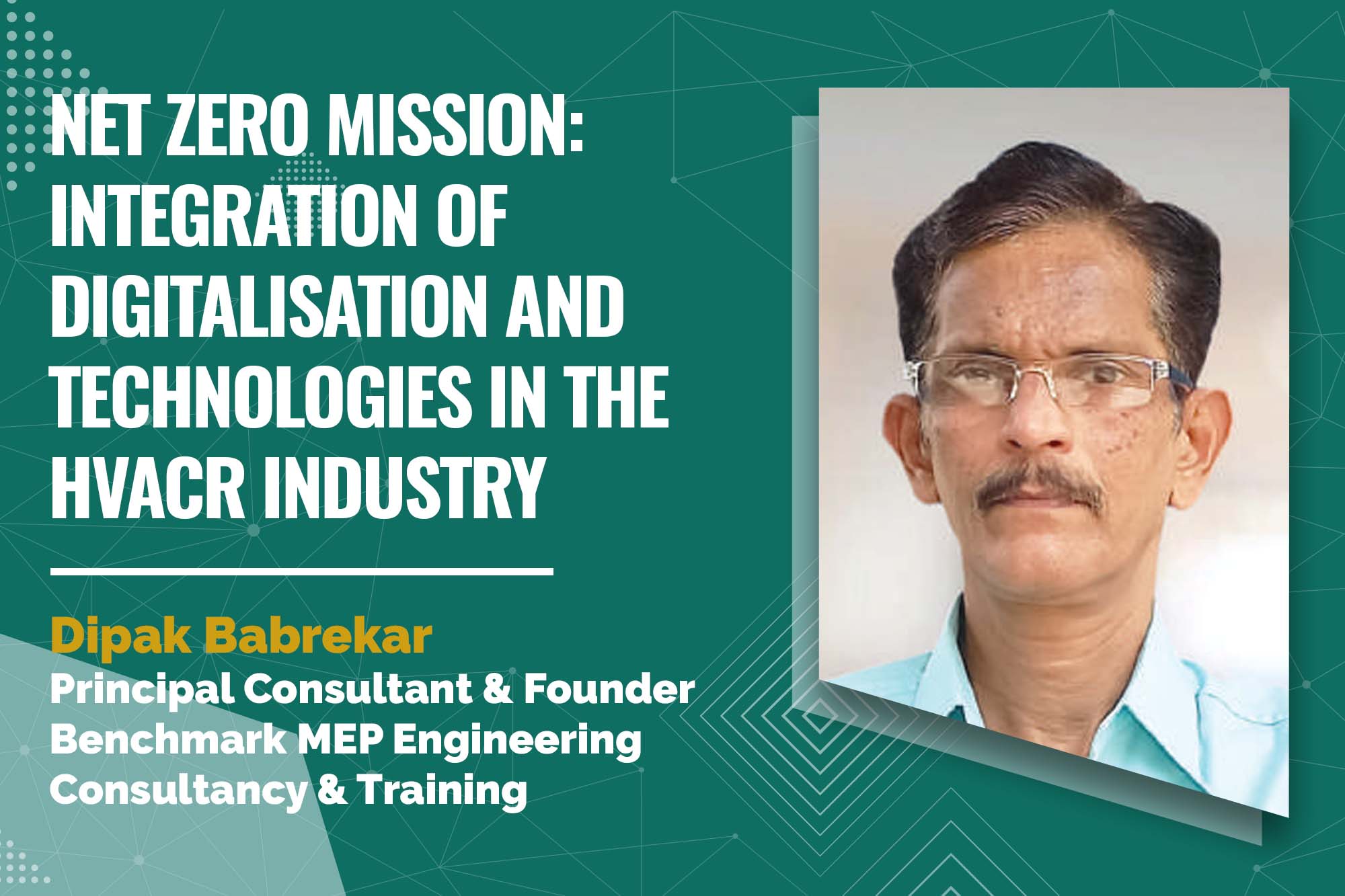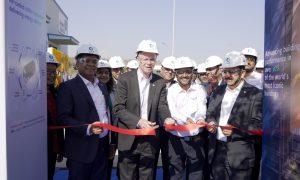In the HVACR industry, a revolutionary wave is happening with digitalisation and innovative products enhancing sustainability and energy efficiency due to reducing carbon footprints, making Net Zero Mission possible by 2070. Dipak Babrekar, Principal Consultant & Founder, Benchmark MEP Engineering Consultancy & Training, explores the potential and challenges of a world where HVACR systems are efficient, intelligently connected and environmentally friendly.
‘One World-Connected HVACR’ represents a paradigm shift, uniting technology, sustainability, and efficiency to create a seamlessly interconnected global ecosystem.
Tech-driven transformations
In 2024, the HVAC industry is poised for significant technological transformations driven by advanced technologies. Artificial Intelligence (AI) and Machine Learning (ML) are becoming integral for predictive maintenance, enabling the industry to foresee potential issues and undertake proactive measures to ensure optimal system performance. The Internet of Things (IoT) is reshaping the HVAC landscape, facilitating seamless integration and remote monitoring and management of HVAC systems. The utilisation of IoT extends beyond mere connectivity, providing valuable data insights that enhance system efficiency and overall performance.
Another noteworthy trend is the incorporation of Virtual Reality (VR) and Augmented Reality (AR) in the HVAC sector. VR is being employed to train technicians, offering immersive simulations for equipment installation, troubleshooting, and maintenance procedures. This enhances the skill set of technicians and contributes to increased efficiency in handling HVAC systems.
Product, innovation and digitalisation
The advancements in the HVAC industry encompass a range of innovative products and digital solutions. Real-time online control of water, electrical, or gas consumption is now achievable through Smart Energy Meters, which operate with or without WiFi connectivity. Smart Air Handling Units (AHUs) represent an advanced solution with integrated control systems capable of connecting to IoT Cloud Systems for enhanced functionality.
The integration of Building Simulation Apps allows the creation of virtual prototypes, facilitating the calculation of heating and cooling performance for buildings or HVAC spaces. Post-pandemic, a heightened focus on Indoor Air Quality (IAQ) is observed, with the adoption of measures such as Bi-Polar Ionizers, UV lights in AHUs, MERV filters, and local air purifiers with PHI cells.
IoT sensors play a crucial role, offering temperature and CO2 level measurements and modulating dampers, facilitating the optimisation of HVAC systems. The incorporation of Hybrid Heat Pumps with higher Coefficient of Performance (COP) addresses both cooling and heating requirements efficiently.
The HVAC industry sees the rise of WiFi/IoT-enabled air conditioners, capable of tracking ambient temperatures and adjusting internal temperatures to optimise energy consumption. Large infrastructure projects can benefit from District Cooling systems, where a single utility chiller plant, coupled with an Intelligent Building Management System (IBMS), serves the entire area.
Radiant Cooling Systems, exemplified by the Surat Diamond Bourse, gain popularity as they cool floors or ceilings by absorbing radiated heat from rooms. Solar-based HVAC units running on solar panels are now available for smaller capacities. The use of CO2 refrigerant systems, witnessed in the Indian Navy’s chilling systems, reflects a move towards environmentally friendly refrigerants.
In alignment with environmental initiatives, Green Credit Systems, a program by the Indian Government, incentivises various environmental efforts beyond just carbon emission reduction. The introduction of ‘Baby Chillers’ with limited capacity addresses space constraints, providing a more versatile cooling solution. These transformative developments collectively shape the future landscape of the HVAC industry.
Market & business model
Anticipated shifts in the HVAC market and business models include a rise in subscription-based models, where manufacturers provide HVAC systems as a comprehensive service, covering installation, maintenance, and performance guarantees. Direct-to-consumer sales are expected to gain prominence, directly selling HVAC products through online platforms and apps, bypassing traditional distribution channels.
A strategic focus on data and analytics is foreseen, with industry players harnessing insights from connected systems to enhance product development, customer service, and targeted marketing efforts. Furthermore, an increase in collaborations is anticipated, with partnerships becoming more common among HVAC manufacturers, energy providers, smart home companies, and technology providers. Additionally, collaborations with green building material suppliers are expected to play a significant role in shaping the evolving landscape of the HVAC market.
IoT Vs. Conventional HVAC System in connecting systems and components
Let us understand by a diagram illustrating Air Handling Units (AHU) linked with IoT sensors, which connect to a Building Management System (BMS) and extend further to a Cloud-Based system.
In traditional HVAC setups, technicians manually inspect the problem if an issue arises on-site. If the site lacks a Building Management System, such matters are managed through a Facility Management system. Hence, the manual process relies on visual inspections, alarms, or logbooks. If spare parts are unavailable, the order time increases, causing losses to the company. This manual approach takes time, and the reactive maintenance period extends, reducing system uptime.
On the other hand, in the case of IoT, all sensors for temperature, air quality, fresh air, modulating dampers, valves, and occupancy, as illustrated in the AHU diagram, serve as data loggers. This allows continuous, 24×7 monitoring without human intervention. This data can be accessed via an app and remotely through interconnected signals, providing insights into past and current issues. The IoT system can indicate which spare parts are needed when components trigger a red signal.
The IoT system details HVAC system performance, predicts future issues, and forecasts energy consumption. This information aids in optimising the system and aligning it with zoning requirements.
AI and IoT enhance HVAC system efficiency
Through the integration of IoT sensors into HVAC systems, a continuous stream of data is collected, encompassing temperature, humidity, airflow, and equipment performance. AI algorithms then analyse this data, identifying potential issues and predicting equipment failures before they manifest. This predictive maintenance approach enables proactive measures, preventing costly breakdowns and extending the equipment’s overall lifespan.
Additionally, implementing intelligent climate control involves utilising smart thermostats, occupancy sensors, and Passive Infrared Detectors (PID). Building simulation techniques are incorporated to optimise HVAC systems, ensuring an efficient and tailored approach to climate control.
Benefits of AI and IoT in HVAC optimisation
Integrating Artificial Intelligence (AI) and the Internet of Things (IoT) in HVAC systems offers several advantages. Firstly, there is a reduction in energy consumption, with studies indicating potential savings of up to 30 percent on energy costs. This is achieved through the real-time optimisation of HVAC system operations, leveraging data from various sources such as weather conditions, building occupancy, and energy prices.
Enhanced occupant comfort is another significant benefit, as personalised climate control and optimised system performance contribute to a more pleasant environment. Additionally, implementing AI enables lower maintenance costs through predictive maintenance, reducing the need for reactive repairs and prolonging the lifespan of equipment.
The sustainability aspect is addressed by reducing energy consumption, resulting in a smaller carbon footprint and less environmental impact. AI also facilitates participation in demand response programs by adjusting energy consumption based on grid demand, potentially earning credits from utility companies.
Furthermore, AI algorithms play a crucial role in fault detection and diagnostics, identifying anomalies in system performance that may indicate underlying issues requiring attention. Introducing smart thermostats adds another layer of efficiency, learning user preferences and schedules to adjust temperatures for optimal comfort and energy savings automatically. These smart thermostats also offer remote control and monitoring capabilities through smartphone apps.
Moreover, advanced cloud-based software platforms provide comprehensive monitoring and control of HVAC systems in commercial buildings. These platforms offer real-time data insights, predictive maintenance capabilities, and tools for energy optimisation, further enhancing the overall efficiency of HVAC systems.
Challenges and considerations for ‘One world – connecting HVACR’
The integration of HVACR systems on a global scale poses various challenges and considerations. One aspect is the initial investment costs associated with advanced HVAC technologies, which may require substantial upfront financial commitments. This necessitates a careful long-term cost-benefit analysis and potential policy incentives, particularly in India, where these costs could contribute to a 10 to 12 percent increase in HVAC and associated accessories project expenses.
Another concern is the availability of a skilled workforce capable of implementing and maintaining smart HVAC systems. The need for trained technicians familiar with new technologies remains a challenge, requiring manufacturers to invest in training programs and forge partnerships to bridge this gap.
The connectivity of HVAC systems introduces cybersecurity concerns, requiring robust measures to prevent cyberattacks and safeguard against data breaches. Additionally, global supply chain disruptions, tied to the continued reliance on international components, can pose production and cost challenges, with uncertainties related to excise duties, material availability, price fluctuations, and delivery delays.
While 5G internet is making inroads in India, the expansion to Tier 2 and Tier 3 cities is expected to take time, impacting the widespread adoption of connected HVAC systems. Convincing consumers to embrace new technologies and subscription models remains challenging despite advancements.
The regulatory landscape further complicates matters, especially transitioning from R-410A refrigerant to lower-global Warming Potential (GWP) alternatives. This shift presents logistical and cost challenges for manufacturers. Additionally, the absence of mandatory policies for energy efficiency consumption values or audit guidance adds to the complexity, emphasising the need for a more stringent regulatory framework.
Lastly, the application of IoT and AI technology in offices, retail, hospitals, and clean rooms is currently more feasible than in residential settings. The adoption rate in these industries is faster, while it may take a longer time for residential use to catch up with these advanced technologies.
Conclusion
In conclusion, from digitalisation and innovative products, it is clear that the future of climate control lies in unity, intelligence, and a commitment to global sustainability as per the sustainable Development Goal (SDG). In the current scenario, let us hold the promise of connected HVACR systems, recognising that their potential goes beyond temperature regulation and comfort. They hold the key to a world where our environments actively contribute to the well-being of the planet and its inhabitants and Net Zero Mission.
Cookie Consent
We use cookies to personalize your experience. By continuing to visit this website you agree to our Terms & Conditions, Privacy Policy and Cookie Policy.















